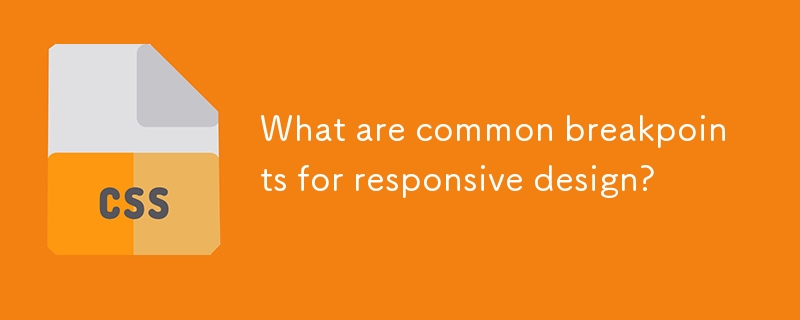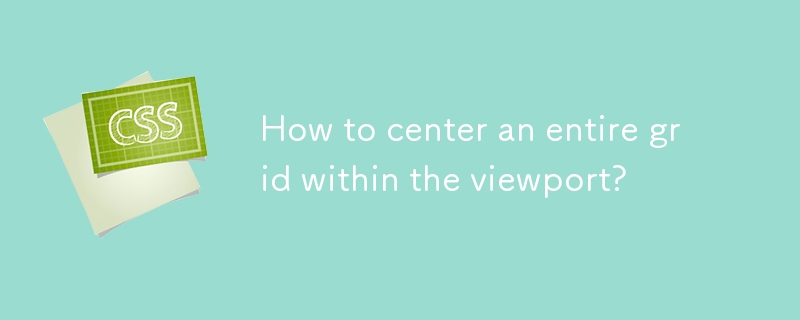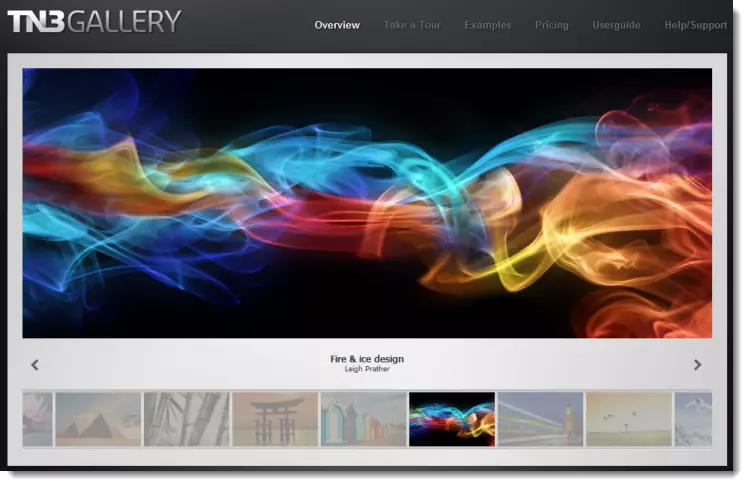Found a total of 10000 related content

What are common breakpoints for responsive design?
Article Introduction:The common breakpoint settings in responsive design are as follows: 1. The vertical screen of the mobile phone (0~767px) adopts a single-column layout, uses max-width:767px media query, optimizes touch operation and content priority; 2. The tablet and small-screen devices (768px~1023px) can introduce two-column layouts, uses min-width:768px and max-width:1023px media query, supports horizontal and vertical screen switching; 3. The desktop devices (1024px and above) use min-width:1024px media query, supports multi-column layout and high-definition image sources; 4. Other supplements include separate processing of mobile horizontal screens, large-screen optimization, focusing on viewport size rather than pixel ratio, and flexible use units. Really good
2025-06-29
comment 0
279

How to create a full-screen landing page with HTML and CSS?
Article Introduction:To create a full-screen landing page, you need to use HTML and CSS to combine viewport units and layout techniques. 1. Set the HTML structure and include viewport meta tags to adapt to mobile devices; 2. Use height:100vh to make the container occupy the full viewport height; 3. Use Flexbox to achieve vertical and horizontal centering of the content; 4. Use background-size:cover and background-position:center to ensure responsive display when adding background images; 5. Optimize the scrolling experience through scroll-behavior or JavaScript to ensure normal display and smooth interaction.
2025-07-07
comment 0
912

Customizing controls for native HTML5 media players.
Article Introduction:To customize HTML5 media player controls, 1. First remove the native controls, remove the controls attribute or set to false; 2. Create custom UI elements such as buttons and progress bars, and use JavaScript to bind events to achieve playback/pause function; 3. Use the timeupdate event to update the playback progress and allow the user to drag and jump; 4. Use the requestFullscreen method to achieve full screen switching; 5. Full control of the style through CSS and adapt to responsive layout.
2025-07-02
comment 0
869

What should I pay attention to when centering the Bootstrap picture
Article Introduction:Bootstrap picture centering tips: Basics: Flexbox and Grid systems are used for layout, and text-center only centers the text baseline horizontally. Horizontal centering: Use justify-content-center attribute (Flexbox), or abuse margin: 0 auto; (unstable). Vertical centering: same as above, add align-items: center; the parent container needs to be set to fixed height. Responsive design: Use responsive classes to control layouts under different screen sizes. Common errors: Forgot to set height, abuse margin, ignore responsive design. Performance optimization: Select the appropriate image format, compress the image volume, and avoid excessively large images. **
2025-04-07
comment 0
852

How to make a responsive website with HTML5 and CSS3?
Article Introduction:The key to making a responsive website lies in the reasonable cooperation between HTML5 and CSS3, and the core is to make web pages display well on different devices. 1. Use HTML5 semantic tags to build clear structures, such as, , etc., to make the code easier to read and facilitate search engine crawling; 2. Use CSS3 media query to achieve multi-device adaptation, and apply different rules by detecting screen width, such as setting breakpoints such as mobile phones and tablets; 3. Use elastic layout (Flexbox or Grid) to deal with alignment and arrangement issues, and ensure that the navigation bar and other content automatically adapt to the screen; 4. Set image adaptation, use max-width:100% and srcset attributes to ensure that the image does not destroy the layout and improve the loading effect. Mastering these four key points can achieve compatibility with multiple settings
2025-07-13
comment 0
495

How to center an entire grid within the viewport?
Article Introduction:To make the entire grid layout centered in the viewport, it can be achieved by the following methods: 1. Use margin:0auto to achieve horizontal centering, and the container needs to be set to set the fixed width, which is suitable for fixed layout; 2. Use Flexbox to set the justify-content and align-items properties in the outer container, and combine min-height:100vh to achieve vertical and horizontal centering, which is suitable for full-screen display scenarios; 3. Use CSSGrid's place-items property to quickly center on the parent container, which is simple and has good support from modern browsers, and at the same time, it is necessary to ensure that the parent container has sufficient height. Each method has applicable scenarios and restrictions, just choose the appropriate solution according to actual needs.
2025-07-02
comment 0
264

TN3 Gallery - #1 Professional Image Gallery
Article Introduction:TN3 Gallery: A powerful custom image library based on HTML5
TN3 Gallery is a new HTML5 image library developed using jQuery, which is highly customizable. I know you might be thinking: "Another picture library plugin?" But TN3 is by no means an ordinary picture library! It represents a new generation of the photo gallery, here are the reasons why you should use it as your preferred photo gallery.
TN3 Gallery demo features:
Amazing loading speed
Advanced Album View: Full Screen Mode is amazing!
Movie-level image transition effect
A wide variety of user-friendly skins to choose from
Professional look and feel
Fully customization via TN3 API
Load your gallery using XML
2025-03-03
comment 0
752

How to center a div in HTML?
Article Introduction:There are many ways to center a div, depending on the centering direction and layout requirements. 1. The horizontal centering block-level div can use margin:0auto, but the width needs to be set and ensure that it is a block-level element; 2. The horizontal and vertical centering can be achieved at the same time with Flexbox, and the container alignment is set through display:flex, justify-content and align-items; 3. The complete centering is achieved using CSSGrid, and the code is simplified through place-items:center; 4. The classic positioning method is suitable for old browsers, and the full screen positioning is achieved by combining absolute positioning with transform:translate (-50%,-50%).
2025-07-13
comment 0
181

Implementing Responsive Images using HTML Picture Element
Article Introduction:Elements are a native way to implement responsive images in HTML5. It allows the most appropriate image resources to be loaded according to factors such as the screen size, resolution, and direction of the device. Define multiple image sources and their corresponding media query conditions through tags. The browser will match and load pictures that meet the conditions in order, and finally use the tag as the default fallback. For example: when the device width is greater than or equal to 1024px, medium.jpg is loaded between 768 and 1023px, small.jpg is loaded if the device width is greater than or equal to 1024px. Compared with srcset, it provides more refined control capabilities, such as adapting to Retina screens, horizontal and vertical screen switching, completely different picture content, etc. Media checks should be set reasonably when using
2025-07-10
comment 0
451

Implementing Native Lazy Loading for HTML5 Images and Iframes
Article Introduction:How to implement lazy loading of images and iframes in HTML5? By adding loading="lazy" attribute to the and tags, the browser delays loading these elements until they are about to enter the viewport. Applicable scenarios include non-first-screen content at the bottom of the page, gallery or product pages with a large number of pictures, content skipped by mobile terminals in responsive design, and pages with multiple iframes embedded. It is not recommended to use lazy loading for key content on the home screen such as logo or banner. Notes include: 1. When it is compatible with old browsers, you must introduce polyfill; 2. Ensure that the search engine can recognize the image content to avoid SEO influence; 3. Set placeholders to prevent layout jitter; 4. Dynamically inserted pictures need to be manually processed and lazy loaded.
2025-07-07
comment 0
409


Dave The Diver: How To Catch Spider Crabs
Article Introduction:In Dave The Diver, there are some creatures that are not easy to catch. Or, catch alive that is. The spider crab is one of those very species, making it seem like the only way to bring these crustaceans back up to land is to viciously crack them up w
2025-01-10
comment 0
809

Prepare for Interview Like a Pro with Interview Questions CLI
Article Introduction:Prepare for Interview Like a Pro with Interview Questions CLI
What is the Interview Questions CLI?
The Interview Questions CLI is a command-line tool designed for JavaScript learners and developers who want to enhance their interview
2025-01-10
comment 0
1437

Soft Deletes in Databases: To Use or Not to Use?
Article Introduction:Soft Deletes: A Question of DesignThe topic of soft deletes, a mechanism that "flags" records as deleted instead of physically removing them, has...
2025-01-10
comment 0
1052



















